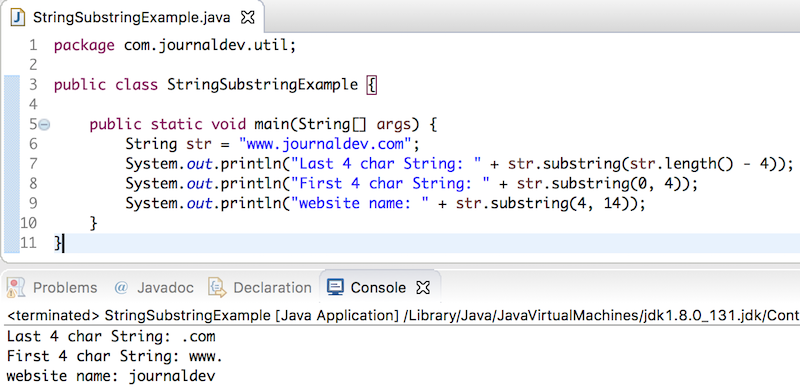

- #Java substring start and end index equals 0 driver
- #Java substring start and end index equals 0 software
- #Java substring start and end index equals 0 code

Larger than the length of this String object. IndexOutOfBoundsException - if beginIndex is negative or Parameters: beginIndex - the beginning index, inclusive. "hamburger".substring(4, 8) returns "urge" "emptiness".substring(9) returns "" (an empty string) The length of the substring is endIndex-beginIndex.Įxamples: "unhappy".substring(2) returns "happy" Negative lengths in substr () are treated as zero, while substring () will swap the two indexes if end is less than start. The substring begins at the specified beginIndexĪnd extends to the character at index endIndex - 1. substr () s start index will wrap to the end of the string if it is negative, while substring () will clamp it to 0. Public String substring(int beginIndex, int endIndex) The substring begins with the "" characterĪt the specified index and extends to the end of this string. Returns a new string that is a substring of this Redefining of course would mean rewriting the entire internet, so it's not likely.įrom String API javadoc: public String substring(int beginIndex) Or the method redefined to match C++ string::substr method. The Java method signature should be: public String substring(int beginIndex, The second parameter is not named correctly.

This is just one of those times that you have to remember the idiosyncrasy of this method. If we rename parameter 2 to "lengthOfSubstringFromIndex0" you don't have to do the endIndex - 1 count, and it never throws the IndexOutOfBoundsException() that is expected when specifying an endIndex, 10, that is out of range for the underlying array. If we use 10 as the 'endIndex' parameter,ĪssertThat(testString.substring(4, 10), equalTo("String")) The length of testString from index 0 to char 'g' in 'String' is 10 chars. If we test the method in JUnit with concrete values looking at the C++ method, we expect:ĪssertThat(testString.substring(4, 6), equalTo("String")) īut of course we get Expected: "String" but was "St" Specifying an endIndex of 10 should always throw the IndexOutOfBoundsException() because testString has no endIndex of 10. TestString has 10 chars, index positions 0 to 9. Number of characters to include in the substring (if the string is shorter, as many characters as possible are used). Note that the second parameter in the method definition is 'len' for length. String substr (size_t pos = 0, size_t len = npos) const From C+++ string class we see the method definition is: We know that Gosling based the Java syntax on the C/C++ languages for familiarity. Length - the length of the string desired beginning at beginIndex. The most likely case is that the second parameter was misnamed. Java/C/C++ and every other language that I know of does NOT view the array index as the 'divider' between array elements.īeginIndex - the beginning index, inclusive.Įither endIndex is misnamed because the language does not allow memory access to the address at endIndex + 1 which is required to include the last array element OR endIndex is mis-defined and must be:
#Java substring start and end index equals 0 software
I view this as a software fault in the Java String.substring(int beginIndex, int endIndex) method. String charAt() function returns the character located at the specified index.I know this thread is quite old but this is such a fundamental problem that I think it warrants clarification.
#Java substring start and end index equals 0 code
We will learn about each method with help of small code examples for better understanding. The methods specified below are some of the most commonly used methods of the String class in Java.
#Java substring start and end index equals 0 driver


 0 kommentar(er)
0 kommentar(er)
